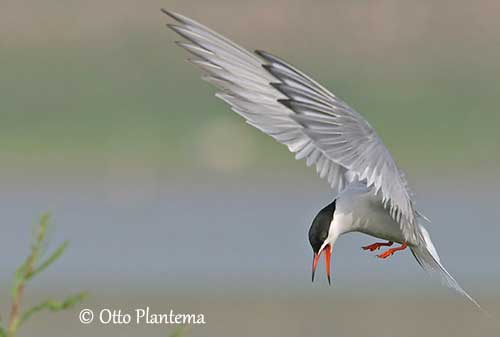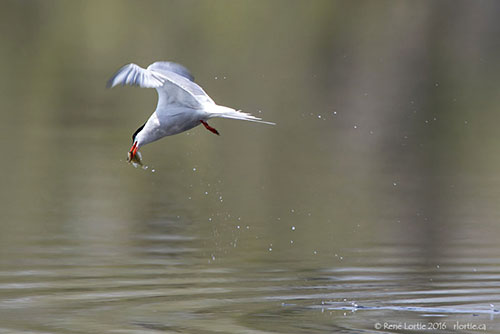
Fr: Sterne pierregarin
Ang: Common Tern
All: Flußseeschwalbe
Esp: Charrán Común
Ita: Sterna comune
Nd: Visdief
Sd: Fisktärna
Photographers:
Roger Ahlman
Pbase Galleries Peru and Ecuador
John Anderson
John Anderson Photo Galleries
Aurélien Audevard
OUESSANT DIGISCOPING
Didier Buysse
Vision d’Oiseaux
Steve Garvie
RAINBIRDER Photo galleries & Flickr Rainbirder
Tom Grey
Tom Grey's Bird Pictures & Tom Grey's Bird Pictures 2
René Lortie
René Lortie photographe & Galeries d'oiseaux sur Pbase
Eugène Montocchio
Galerie Photos Nature & Chez Gégène
Otto Plantema
Trips around the world
Jean Marc Rabby
Des Ailes et des Plumes
Text by Nicole Bouglouan
Sources:
HANDBOOK OF THE BIRDS OF THE WORLD Vol 3 by Josep del Hoyo-Andrew Elliott-Jordi Sargatal - Lynx Edicions - ISBN : 8487334202
THE COMPLETE BOOK OF BRITISH BIRDS – Written by “Royal Society for the Protection of Birds” experts - Préface de Magnus Magnusson - Michael Cady- Rob Hume Editors - ISBN: 0749509112
THE HANDBOOK OF BIRD IDENTIFICATION FOR EUROPE AND THE WESTERN PALEARCTIC by Mark Beaman, Steve Madge - C. Helm - ISBN: 0713639601
All About Birds (Cornell Lab of Ornithology)
Wikipedia, the free encyclopaedia
What Bird-The ultimate Bird Guide (Mitchell Waite)
Bird Web (Seattle Audubon Society)
Department of Sustainability, Environment, Water, Population and Communities
Common Tern
Sterna hirundo
Charadriiformes Order – Laridae Family
INTRODUCTION:
The Common Tern is an elegant seabird relatively widespread throughout its large range. It is also named “sea-swallow” referring to its forked tail and fast flight. The Common Tern is often seen hovering over water before plunging down for a prey.
It breeds in noisy, huge colonies that mix elegance and pugnacity when the birds are disturbed by intruders, usually greeted with noisy swoops from the offended terns.
The Common Tern has circumpolar distribution and breeds in temperate and subarctic regions of Europe, Asia and North America where it frequents a variety of aquatic habitats in both coastal and inland waters. But it is strongly migratory and spends the winter along the coasts in subtropical and tropical warm waters.
Like numerous seabirds, this species is threatened by disturbance at colonies, fluctuation of water levels, habitat loss due to coastal development, erosion and pollution. However, the Common Tern is not globally threatened with fairly large populations.

DESCRIPTION OF THE BIRD:
Biometrics:
Length: 32-39 cm
Wingspan: 72-83 cm
Weight: 102-135 g
The Common Tern in breeding plumage has pale silvery-grey upperparts. On the upperwing, the outer primaries have black tips. On the head, forehead, crown, nape and hindneck are black, extending below the eye. Cheeks, chin and throat are white. The underparts are pale whitish grey. On the underwing, leading and trailing edges are mostly dark. The deeply forked tail has elongated outer rectrices. The outer edges of the tail feathers are dark grey, but the uppertail-coverts are white.
The bill is blackish with red base. The eyes are dark brown. Legs and feet are dark red.
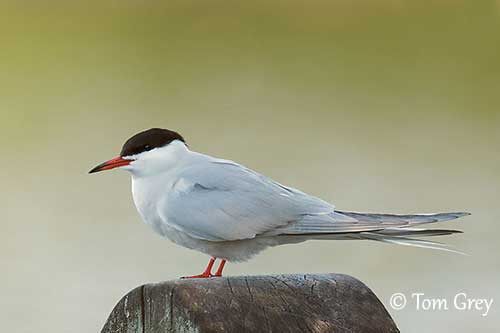
Male and female are similar.
The winter plumage shows less extended black on head, with whitish face and forehead. Bill and legs become black.
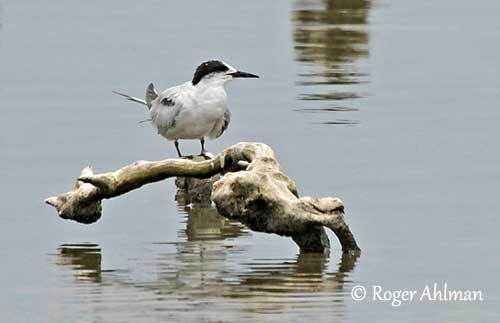
The juvenile is much browner in appearance. It has neat black cap, and the white forehead is washed with brown on very young birds. The tail is shorter and lacks the elongated streamers. The legs are pinkish to orange-brown. The bill is dark with pinkish or yellowish base.
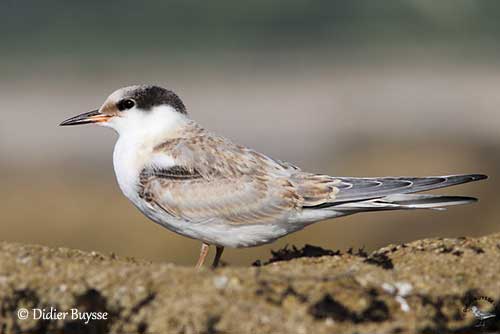
The immature resembles adult, but it has whiter forehead, speckled forecrown and faint dark bars on back.

SUBSPECIES AND RANGE:
The Common Tern has four subspecies.
S.h. hirundo is found in North America (C and E Canada, N and E USA) to N South America, Atlantic islands, Europe, N Africa (Tunisia) and W Africa, through Middle-east and Black and Caspian Seas to Yenisei Valley. It winters S of Tropic of Cancer.
S.h. minussensis occurs in C Asia from upper Yenisei Valley E to Baikal and N Mongolia. It winters in N Indian Ocean.
S.h. tibetana is found in W Mongolia S to Kashmir, and SW and SC China at high altitudes. It winters in E Indian Ocean.
This race is slightly darker above and below, and has shorter bill.
S.h. longipennis occurs in NE Siberia S to NE China. It winters in E Indian Ocean and SE Asia to Australia, and rarely in New Zealand.
This one has blackish bill and red-brown to blackish-brown legs and feet.
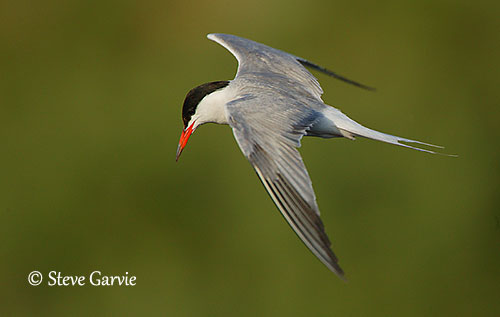
HABITAT:
The Common Tern breeds on low-lying inshore islands, sandpits and beaches. It also nests inland along slow-flowing rivers, and by lakes in open country. It favours areas with close shallow waters for fishing.
During migration, it can be seen mainly along coasts, in estuaries and freshwater inland lakes. But during winter, it is mostly coastal and occurs in warm subtropical and tropical waters.
CALLS AND SONGS: SOUNDS BY XENO-CANTO
The Common Tern gives high, grating “keey-yah” or “kye-kye-kye-kye…” and a characteristic “kirri-kirri”. The alarm call is a high-pitched “kreeeah” or “kreeerr”. The migrating or feeding birds utter a short “kik” often repeated.
The juveniles accompanying adults give shrill, repeated “kee”.
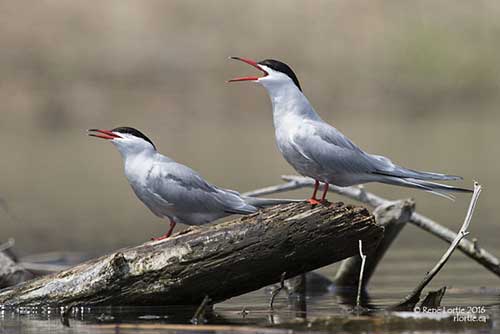
BEHAVIOUR IN THE WILD:
The Common Tern feeds mainly on fish, usually a variety of small fish most easily available. It also takes shrimps and other crustaceans, marine worms, small squid and leeches.
The diet varies depending on the season, and this opportunistic tern readily switches to other prey when its preferred food items are not available.
The Common Tern forages by flying over water and hovering. Plunge-diving is frequently used to catch prey below the surface. Contact-dipping shows the bird swooping down towards the water and catching a prey by dipping the bill just below the surface. It also swims on the water while picking food items from the surface or just below.
The Common Tern also pursues and hawks aerial insects in the air. It also steals food from other terns. They often form feeding flocks around rich food sources.
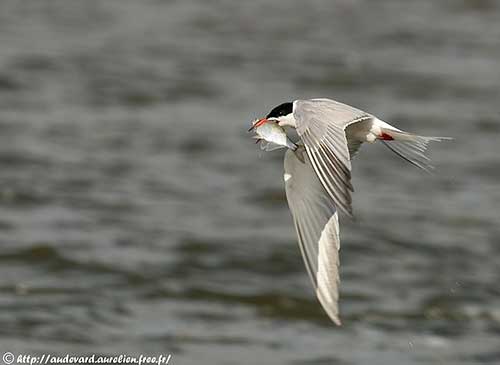

The courtship displays are usually initiated when the male brings back a fish and offers it to the female. She may swallow it immediately or keep it in her bill during the displays.
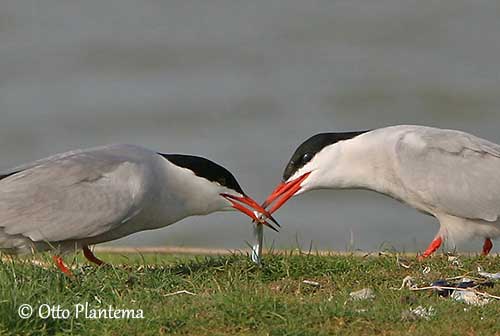
They perform aerial displays high in the air and fly in tandem. Once the pair if formed, the intensity of displays increases and courtship feeding is common. The copulation usually follows the fish-transfer.

But it may follow other displays performed on the ground. Both mates circle around each other with slightly drooped wings and lowered bill. Then, the male raises the bill in a full “upright-display” while calling softly. Both mates dance around each other during several minutes, prior to copulation. They are monogamous.
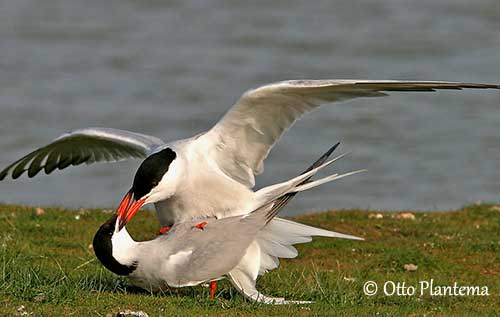
The Common Tern is migratory, and moves S between late August and October, and returns to the breeding grounds in March/April.
The flight is slower than that of gulls and more buoyant with rapid wingbeats.
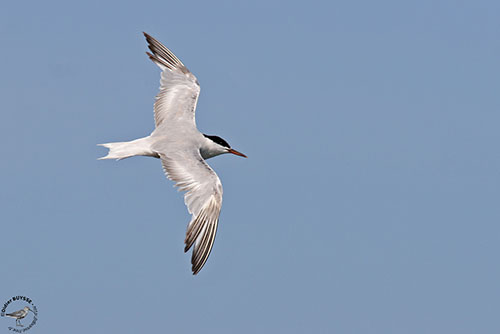
REPRODUCTION OF THIS SPECIES:
The breeding season takes place in spring with the laying in April/June.
The Common Tern breeds in huge colonies, but also as isolated pairs. The colonies are established in both coastal and inland areas, sometimes up to 4000 metres of elevation (race tibetana), but more usually on sandy beaches, vegetated inter-dune areas, islands in estuaries or near lakes and rivers.
The nest is on the bare ground, sometimes surrounded by low vegetation or on floating dead vegetation. Both adults build the nest, a shallow scrape lined with pieces of plant material and debris.

The female lays 2-3 cryptic pale eggs with dark markings. Both adults incubate during 21-25 days. The chicks leave the nest after a few days, but they remain in the surrounding where they are fed by their parents. They fledge about 22-28 days after hatching, but they still remain in family group for two months or more.
This species produces a single brood per season, rarely two.
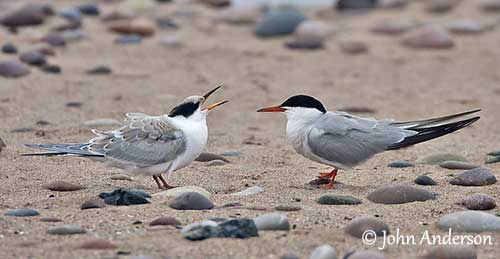
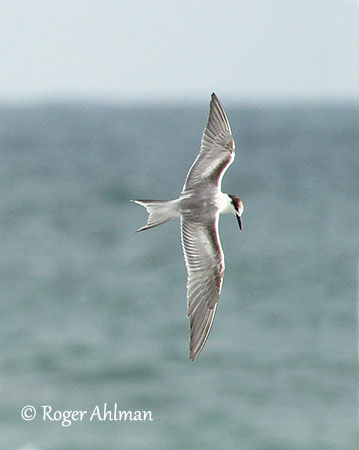
PROTECTION / THREATS / STATUS:
The Common Tern has wide range, but it is threatened by human disturbance at colonies though the increase of recreational activities, flooding of nest-sites with natural fluctuation of water-levels, habitat loss due to coastal development, erosion, invasive vegetation on nesting sites and pollution.
The global population is estimated to number 1,600,000/4,600,000 individuals (2006) and is decreasing.
But currently, the Common Tern is still evaluated as Least Concern.
